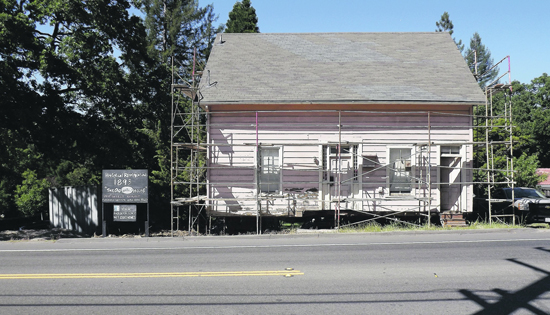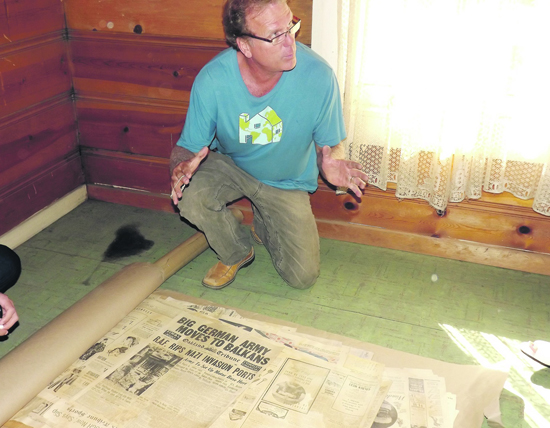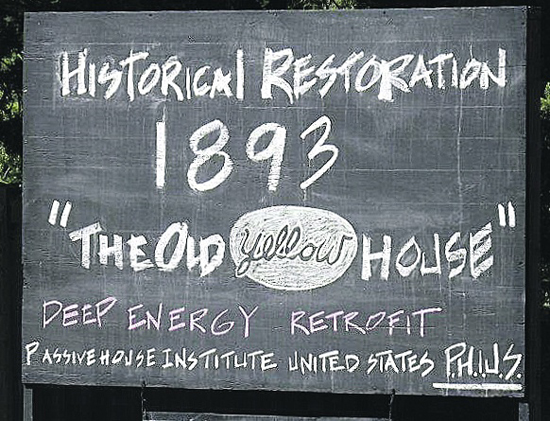 | | | The scaffold-enclosed Old Yellow House is off its foundations while being refurbished. Photos Cathy Dausman
| | | | | | A colorful Orinda home and its storied past is becoming environmentally green, thanks to a new owner. The Old Yellow House, as it was originally known, has actually been pink since 1991 and unoccupied since 1966. But new owner James Wright said he is excited to begin his restoration project, emphasizing that he plans to refurbish rather than replace. His enthusiasm for the work to be done and his affection for the Orinda landmark is quite contagious.
 Wright consulted with Orinda's Historical Landmarks Committee (HLC) to insure that the house "should look as close as possible to its original form." He introduced himself to neighbor and former resident Ezra Nelson, tapped Nelson's memories of how the house once was, applied for a historic landmark designation for the house, and plans to refurbish the dwelling, inside and out.
Wright consulted with Orinda's Historical Landmarks Committee (HLC) to insure that the house "should look as close as possible to its original form." He introduced himself to neighbor and former resident Ezra Nelson, tapped Nelson's memories of how the house once was, applied for a historic landmark designation for the house, and plans to refurbish the dwelling, inside and out.
 Its exterior will be repainted close to its original yellow color and the inside will be made environmentally green. Wright is a renewable energy architect who plans to live and work at that address, while using it as a model for a zero-energy environment. Four HLC members and Assistant City Planner Roscoe Mata recently toured the site. The group approved Wright's exterior color choice. "I am so glad it's being preserved," said HLC member Kay Norman. "The feeling up here [second story] is so nice," said another. Nelson approves of the makeover, too.
Its exterior will be repainted close to its original yellow color and the inside will be made environmentally green. Wright is a renewable energy architect who plans to live and work at that address, while using it as a model for a zero-energy environment. Four HLC members and Assistant City Planner Roscoe Mata recently toured the site. The group approved Wright's exterior color choice. "I am so glad it's being preserved," said HLC member Kay Norman. "The feeling up here [second story] is so nice," said another. Nelson approves of the makeover, too.
 Work on the house is planned in two phases: Phase I, currently underway, included raising the house 24 inches above grade, constructing seismic shear walls in the basement, and building a new front entry landing. Raising the house was not difficult, said Wright, noting its weight was probably not much more than a truckload of lumber. The original redwood shiplap siding will be removed and reinstalled over an inward facing radiant barrier and three inches of rigid foam insulation. For now, Wright simply plans to maintain the existing plumbing, heating and knob and tube wiring.
Work on the house is planned in two phases: Phase I, currently underway, included raising the house 24 inches above grade, constructing seismic shear walls in the basement, and building a new front entry landing. Raising the house was not difficult, said Wright, noting its weight was probably not much more than a truckload of lumber. The original redwood shiplap siding will be removed and reinstalled over an inward facing radiant barrier and three inches of rigid foam insulation. For now, Wright simply plans to maintain the existing plumbing, heating and knob and tube wiring.
 During Phase II, Wright will focus on siding, windows and architectural features, and upgrade the electrical wiring. Double pane windows will hang inside restored original window casings. A second story bath will be built along the landing; a main floor bath will be cantilevered off the back. Wright is installing an energy recovery fresh air ventilation system plus a new integrated solar electrical skylight and entry canopies. All of this will bring the house up to Net Zero Passive House Institute US (PHIUS) standards.
During Phase II, Wright will focus on siding, windows and architectural features, and upgrade the electrical wiring. Double pane windows will hang inside restored original window casings. A second story bath will be built along the landing; a main floor bath will be cantilevered off the back. Wright is installing an energy recovery fresh air ventilation system plus a new integrated solar electrical skylight and entry canopies. All of this will bring the house up to Net Zero Passive House Institute US (PHIUS) standards.
 Work on Phase I began in early May. Wright estimates the foundation work will take about a month and siding work should take another two months. He said the inside work will be "pretty easy," and expected the bulk of the project to be completed by September.
Work on Phase I began in early May. Wright estimates the foundation work will take about a month and siding work should take another two months. He said the inside work will be "pretty easy," and expected the bulk of the project to be completed by September.
 Muir Sorrick's 1970 History of Orinda stated ship captain Alexander Jenkins bought the home's 2.2-acre site in 1894. The local newspaper described the house he built as "a real commodious cottage." A goldenrod yellow paint, possibly the same color used by the California and Nevada Railroad, made it appear to be a railroad station house, but it was always a private residence.
Muir Sorrick's 1970 History of Orinda stated ship captain Alexander Jenkins bought the home's 2.2-acre site in 1894. The local newspaper described the house he built as "a real commodious cottage." A goldenrod yellow paint, possibly the same color used by the California and Nevada Railroad, made it appear to be a railroad station house, but it was always a private residence.
 It was said Jenkins liked the barn on his property, but not the house, which may explain why he sold it. Nelson said his father, Charles, bought the house from Felix Fazio in 1918. Back then it had no plumbing, gas or electricity. Charles raised his family there, and his widow remained until her death in 1966. Ezra Nelson lived in the house from 1924 until 1952, when he moved into the "cottage" next door.
It was said Jenkins liked the barn on his property, but not the house, which may explain why he sold it. Nelson said his father, Charles, bought the house from Felix Fazio in 1918. Back then it had no plumbing, gas or electricity. Charles raised his family there, and his widow remained until her death in 1966. Ezra Nelson lived in the house from 1924 until 1952, when he moved into the "cottage" next door.
 Today the Old Yellow House sits on a half-acre lot, adjacent to the San Pablo Creek. Birch, cedar, oak and fig trees surround a single car garage.
Today the Old Yellow House sits on a half-acre lot, adjacent to the San Pablo Creek. Birch, cedar, oak and fig trees surround a single car garage.
 A full basement was dug by hand in 1928; it later housed the home's only bath. Interior walls are pine; the second floor stair rail is redwood. The second story is framed with 2 x 3 rough cut studs. The kitchen flooring is checkered linoleum; room-sized pieces of linoleum covered most other floors. Newspapers dating from the 1940s were layered underneath the linoleum to provide insulation. These were a bonus find for Wright, who said he will preserve and frame them to use as interior wall dividers.
A full basement was dug by hand in 1928; it later housed the home's only bath. Interior walls are pine; the second floor stair rail is redwood. The second story is framed with 2 x 3 rough cut studs. The kitchen flooring is checkered linoleum; room-sized pieces of linoleum covered most other floors. Newspapers dating from the 1940s were layered underneath the linoleum to provide insulation. These were a bonus find for Wright, who said he will preserve and frame them to use as interior wall dividers.
 Wright calls the original framework "optimized framing." The spacing between each piece of lumber allows for more added insulation, he said. Wright intends to keep the second story close to its original condition, while restoring the main level and upgrading the basement to a "high tech" environment. The basement will house his home office and a working kitchen. Wright also hopes to highlight a portion of the original basement stone wall behind glass. He said his deep energy retrofit will act as sound insulation so most Moraga Way traffic noise will disappear. He'll install twin energy recovery ventilation (ERV) systems in the basement using an on-site well as a water source.
Wright calls the original framework "optimized framing." The spacing between each piece of lumber allows for more added insulation, he said. Wright intends to keep the second story close to its original condition, while restoring the main level and upgrading the basement to a "high tech" environment. The basement will house his home office and a working kitchen. Wright also hopes to highlight a portion of the original basement stone wall behind glass. He said his deep energy retrofit will act as sound insulation so most Moraga Way traffic noise will disappear. He'll install twin energy recovery ventilation (ERV) systems in the basement using an on-site well as a water source.
 The Old Yellow House restoration project is being documented at http://www.facebook.com/home.php?ref=wizard#!/NetZeroHomes. Its changes might even make Alexander Jenkins smile.
The Old Yellow House restoration project is being documented at http://www.facebook.com/home.php?ref=wizard#!/NetZeroHomes. Its changes might even make Alexander Jenkins smile.

|


